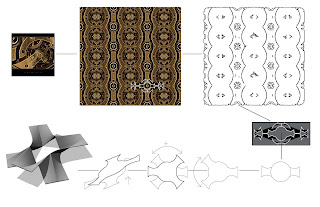3D-Pattern-Process


Pinboard
1: To set the rules for the movements on my pinboard, I invented a schedule for the two occupants. To keep it simply and basic I decided to choose a pretty normal day of a couple.
Having set up a schedule for my inhabitants, I moved on transvering the schedule on the pinboard.
2: Transfering the movement the inhabitants have to make for their daylife, the animation saves the paths and shows a obvious arrangement of the spaces needed for their actions.
3: With the results from the first pinboard I organized the minimun spaces that are needed for every type of action. All spaces have a distance of one square in between.
4: Folowing the same schedule again and the simple rule, that any space expands by one square in all directions in case of being occupied, the second animation shows how the spaces could react to the users movements.
Spaces
Organizing minimum spaces
Paths
Schedule
Pattern-Animations
The following movies show the movements of an interactive pattern.
Bottom: This is one of my first tries and shows how flexible the pattern is and what limits are given through the structure.
Top: This video is a translation from my studies with the pinboards. It shows how the pattern could react to the actual movements of the inhabitants. Every time a space is occupied the pattern forms a shell and creates the spaces that is specifacly needed by the occupand(s). When a space is not in use it shrinks to its normal shape.